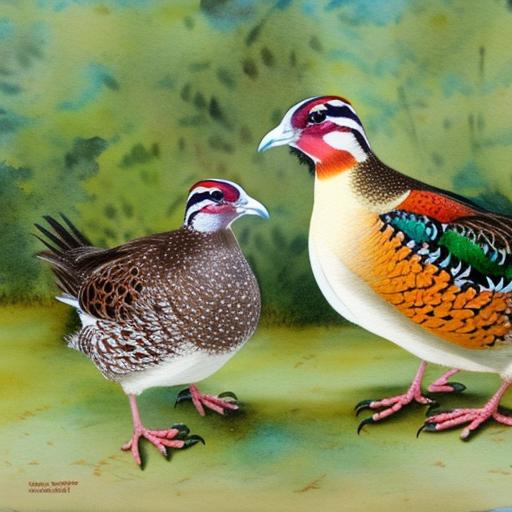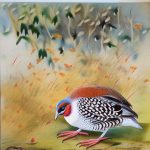Quails are small, ground-dwelling birds that belong to the pheasant family. They are known for their delicious meat and eggs, and are popular in many cuisines around the world. In India, quail farming has gained popularity in recent years due to the high demand for quail meat and eggs. There are several breeds of quail that are native to India, each with its own unique characteristics and qualities. These breeds are well-suited to the Indian climate and are relatively easy to rear, making them a popular choice for farmers and hobbyists alike.
Key Takeaways
- Indian quail breeds are gaining popularity in the poultry industry due to their small size and high egg production.
- Popular Indian quail breeds include the Japanese quail, Bobwhite quail, and King quail, each with unique characteristics and traits.
- Indian quail breeds are known for their adaptability to various climates, high egg production, and fast maturity rate.
- Breeding and rearing Indian quail requires proper housing, feeding, and management to ensure optimal growth and egg production.
- Indian quail are used for their meat and eggs, as well as for ornamental and hobby purposes, making them a versatile poultry option for farmers and enthusiasts.
Popular Indian Quail Breeds
One of the most popular Indian quail breeds is the Japanese quail, also known as the Coturnix quail. This breed is known for its fast growth rate and high egg production, making it a favorite among quail farmers. Another popular breed is the Bobwhite quail, which is native to North America but has been successfully bred in India. The Bobwhite quail is known for its flavorful meat and is often used in gourmet dishes. The King quail, also known as the button quail, is another popular breed in India. This breed is known for its small size and colorful plumage, making it a favorite among hobbyists and bird enthusiasts.
Characteristics of Indian Quail Breeds
Indian quail breeds are known for their hardiness and adaptability to different climates. They are well-suited to the Indian climate and can thrive in both hot and cold temperatures. Indian quails are also known for their high egg production, with some breeds laying up to 300 eggs per year. In addition, Indian quails are relatively small in size, making them easy to rear and manage. They are also known for their delicious meat, which is lean and flavorful.
Breeding and Rearing Indian Quail
Breeding and rearing Indian quail is relatively easy and straightforward. Quails can be bred in cages or in free-range systems, depending on the farmer’s preferences and resources. They require minimal space and can be reared in small backyard setups or on a larger commercial scale. Quails are omnivorous birds and can be fed a diet of commercial quail feed, supplemented with grains, greens, and insects. They require clean water and a dry, well-ventilated environment to thrive. Breeding Indian quail is also relatively simple, with females laying eggs at around 6-8 weeks of age. The eggs can be hatched in an incubator or under a broody hen, and the chicks require minimal care and attention.
Uses of Indian Quail
Indian quails have several uses, including meat production, egg production, and as pets or ornamental birds. Quail meat is lean and flavorful, making it a popular choice for gourmet dishes and high-end restaurants. Quail eggs are also in high demand due to their rich flavor and high nutritional value. In addition, Indian quails are often kept as pets or ornamental birds due to their small size and colorful plumage. They are also used for hunting and as training birds for bird dogs.
Challenges in Rearing Indian Quail

While Indian quails are relatively easy to rear, there are several challenges that farmers may face. One of the main challenges is disease management, as quails are susceptible to several common poultry diseases. Farmers must take precautions to prevent disease outbreaks and ensure the health of their flock. Another challenge is market access, as quail meat and eggs may not be as widely available or accepted as other poultry products. Farmers may need to work with local markets or restaurants to create a demand for their products.
Conclusion and Future of Indian Quail Breeds
In conclusion, Indian quail breeds are well-suited to the Indian climate and have several uses, including meat production, egg production, and as pets or ornamental birds. They are relatively easy to rear and manage, making them a popular choice for farmers and hobbyists alike. However, there are several challenges that farmers may face, including disease management and market access. Despite these challenges, the future of Indian quail breeds looks promising, as the demand for quail meat and eggs continues to grow in India and around the world. With proper management and care, Indian quails can be a profitable and rewarding venture for farmers.
If you’re interested in learning more about Indian quail breeds, you might also want to check out this informative article on large chicken coop ideas. Understanding the housing needs of different poultry species is essential for successful breeding and rearing, and this article provides valuable insights into creating suitable living spaces for various types of poultry, including quails.
FAQs
What are the different breeds of Indian quail?
There are several breeds of Indian quail, including the Japanese quail (Coturnix japonica), the Bobwhite quail (Colinus virginianus), and the King quail (Excalfactoria chinensis).
What are the characteristics of Indian quail breeds?
Indian quail breeds are known for their small size, mottled brown feathers, and distinctive calls. They are also popular for their high egg production and fast growth rate.
What is the typical habitat for Indian quail breeds?
Indian quail breeds are found in a variety of habitats, including grasslands, agricultural fields, and scrub forests. They prefer areas with dense vegetation for cover and open spaces for foraging.
What is the diet of Indian quail breeds?
Indian quail breeds are omnivorous and feed on a diet of seeds, insects, and small invertebrates. They are also commonly fed commercial quail feed in captivity.
Are Indian quail breeds suitable for backyard farming?
Yes, Indian quail breeds are popular for backyard farming due to their small size, low maintenance, and high egg production. They are also relatively quiet and can be kept in small enclosures.
Meet Walter, the feathered-friend fanatic of Florida! Nestled in the sunshine state, Walter struts through life with his feathered companions, clucking his way to happiness. With a coop that’s fancier than a five-star hotel, he’s the Don Juan of the chicken world. When he’s not teaching his hens to do the cha-cha, you’ll find him in a heated debate with his prized rooster, Sir Clucks-a-Lot. Walter’s poultry passion is no yolk; he’s the sunny-side-up guy you never knew you needed in your flock of friends!







